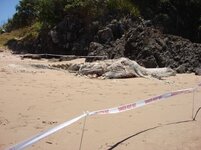- Joined
- Nov 19, 2002
- Messages
- 4,674
Here are a few of the pictures from two recent strandings.
The first 4 are of a small(ish) Gray's Beaked Whale that stranded just west of where we are based, in Manukau Harbour. The whale had been transported from a beach to enable us to undertake our work without being observed, for burial (off the beach) and for some other 'testing' that I'll not go into.
It was a wet and windy day; that's Emma Beatson dressed up in whites, using her new flensing knives to open the whale, and Karl McLeod from NZ's Department of Conservation helping out.
The stomach of this whale was empty. We have removed the entire alimentary tract and will shortly go through the entire intestine looking for trace remains of anything (the diet of this species is unknown). It was a rather unusual location for one of these relatively rare whales to strand, and one of 5 to do so over the past few weeks.
The knives worked a charm!
The first 4 are of a small(ish) Gray's Beaked Whale that stranded just west of where we are based, in Manukau Harbour. The whale had been transported from a beach to enable us to undertake our work without being observed, for burial (off the beach) and for some other 'testing' that I'll not go into.
It was a wet and windy day; that's Emma Beatson dressed up in whites, using her new flensing knives to open the whale, and Karl McLeod from NZ's Department of Conservation helping out.
The stomach of this whale was empty. We have removed the entire alimentary tract and will shortly go through the entire intestine looking for trace remains of anything (the diet of this species is unknown). It was a rather unusual location for one of these relatively rare whales to strand, and one of 5 to do so over the past few weeks.
The knives worked a charm!




















